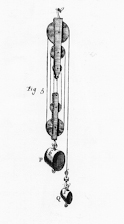
Diameters: 1.5; 3; 4.5; 6 e 7.5
Iron and brass
INDEX 1788 : F.III.133
Polyspaston, in cujus duabus capsulis ferreis dispositi sunt Orbiculi quinque, quorum diametri sunt in progressione arithmetica numerorum naturalium.
Block, in whose two iron frames are five small wheels, the diameters of which are in arithmetic progression of the natural numbers.
In this block the upper, fixed, set of pulleys, consists of three pulleys with radii of 1.5 cm, 4.5 cm and 7.5 cm, while the lower set, movable, has two pulleys with radii of 3 cm and 6 cm. The differences of the radii, and the order in which the pulleys are mounted, are important in order to avoid different sections of the pulley rope becoming entangled. The sizes were also chosen so that the sections of the rope between the pulleys should be parallel to each other.
The weight of the body suspended from the moveable set is distributed between five vertical sections of rope; thus, in order to achieve a balance, there has to be a ratio of 1 to 5 between the weights of the two objects suspended from the block. In order to keep one of the objects suspended, therefore, the force applied to the free end of the rope must be equal in strength to one fifth of the weight of the object hanging from the moveable section.
From Colégio dos Nobres, catalogue n.º 125.'s Gravesande, Willem Jacob, Physices Elementa, Leiden, 1742. Vol.I, § 266, Tab. XI, Fig.5.